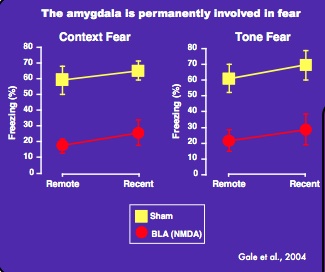PSYC
2: Biological Foundations - Fall 2012 - Professor Claffey
Notes: Cognition 3
Version:
11/26/12 - original version
Motivation & Reward
Questions:
How can experimenters manipulate the brain directly to drive behavior?
What happens in the brain when an experience is rewarding?
How are reward and learning related in the brain?
Experiment: Lever Press
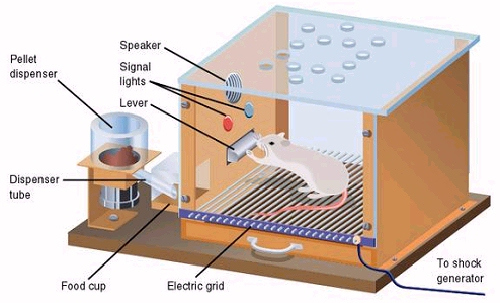
Source: sccpsy101.com/home/chapter-4/section-16/
|
Task:
Animals learn to press a lever to have a reward delivered
Rewards: food, water, sexual mates, drugs
Result:
Animals will lever press 100s of times per hour for reward
this is __________________
learning to behave in a way to produce a favorable outcome
contrasts with ____________________
learning that two things are associated but doesn't require any action/behavior for the subject
(like ____________________ task)
|
Experiment: Intracrancial self-stimulation (ICSS)
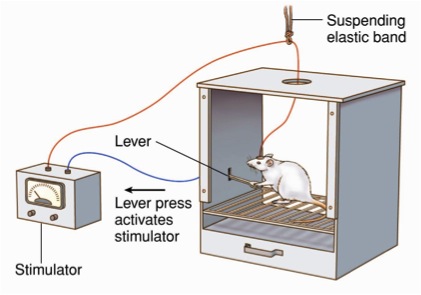
|
Discovered by Olds and Milner (1954)
Task:
Animal has electrode implanted into certain brain areas
(exact areas described below, doesn't work in most areas)
Same as lever press task, but instead of a physical reward the
animal's brain is electrically stimulated
Result:
Rats will press the bar 1000s of times per hour for stimulation
Rats will forgo food in favor of ICSS to the point of starvation
Theory:
The areas were electrodes can produce extensive self-stimulation are the "pleasure centers" of the brain
|
Dopamine & Intracranial Self-stimulation (ICSS)
review:
dopamine - a monoamine neurotransmitter like _______________________________________________
Produced by cells in the brain stem and released broadly throughout brain
background:
________________________ dopamine system - a group of neurons involved in distributing dopamine in the brain
more in "Pathways" section below
Findings that imply that dopamine is involved in ICSS
Most of the sites of self-stimulation are in the mesocorticolimbic dopamine system
Lesions of the mesocorticolimbic system disrupt self-stimulation
Stimulation increases release of dopamine
Dopamine agonists increase self-stimulation and antagonists decrease it
Summary: dopamine seems to be critical to self-stimulation and reward seeking behavior
Dopamine Pathways

|
Mesotelenchephalonic dopamine system
Neurons that produce dopamine have cell bodies in the:
substantia nigra
project to dorsal striatum (basal ganglia)
nigrostriatal pathway
involved in ____________________________
ventral tegmental area (VTA)
project to cortex including nucleus accumbens
(and other areas)
mesocorticolimbic pathway
involved in ____________________________
|
Nucleus Accumbens - site of _______________________________
Dopamine, Learning & Reward

Review: Schultz, J Neurophys, 1997
|
Task:
Electrodes recording from dopaminergic neurons in
substantia nigra & VTA
Animals learn that a conditioned stimulus (CS) predicts a reward
Results:
If a reward comes unexpectedly, dopamine neurons fire
If the CS predicts a reward, dopamine neurons fire at CS but not for the reward
If the CS predicts a reward but the reward doesn't arrive, neurons are inhibited at time of expected reward
Summary:
Dopaminergic neurons don't simply fire at a rewarding experience, but at ____________________________ reward
Dopamine aids learning by signalling ____________ events and may facilitating synaptic changes
|
Theory:
We don't have a "pleasure system" just
because it feels good - organisms consumed with pursuing pleasure for
its own sake would probably not be adaptive.
Our "pleasure system" is an important and possibly critical part of
____________. By drawing our attention to unexpected, positive outcomes,
we focus on and try to repeat behavior that produces these better
outcomes.
Addiction
Theory:
drug addiction involves reward-seeking behavior
reward-seeking behavior (ICSS) involves the mesocorticolimbic system
does drug addiction depend on the mesocorticolimbic system and dopamine?
Drugs that affect dopamine
Cocaine - blocks dopamine ____________ (more dopamine in the synapse)
Amphetamine - ______________ dopamine reuptake (more dopamine in the synapse)
but not all drugs act on dopamine, so dopamine can't be the only answer
(morphine on opiod receptors, MDMA on serotonin)
Evidence for Dopamine & Addiction
Animals will self-administer addictive drugs, similar to how they behave with ICSS
Dopamine antagonists block self-administration of drugs and rewarding aspects of food
Lesions to nucleus accumbens or VTA block self-administration of drugs
Drugs and other reinforcers are associated with elevated dopamine in nucleus accumbens
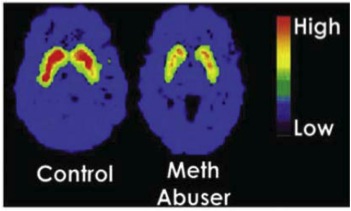
Source: Volkow et al, 2009
|
PET scan (positron emissions tomography)
- Uses radioactive isotopes to observe where molecular reactions are occurring in the brain
- Not precise in time, somewhat precise in location, but allows for
observing specific ____________________
Result:
Ratings of how pleasurable a high is correlate with:
increasing cocaine dose and PET cocaine binding with dopamine receptors (Volkow et al, 2004)
increasing amphetamine dose and PET levels of dopamine in the nucleus accumbens (Drevets et al, 2001)
Meth abusers have less dopamine binding to dopamine receptors than non-using control subjects (Volkow et al, 2009)
|
Theory of Dopamine & Addiction
Drugs that affect synaptic dopamine are short-circuiting the dopamine reward/learning system
During drug use, there is excessive dopamine activity compared to typical, daily rewards
With excessive dopamine activity, neurons produce ____________ dopamine receptors
the dopamine signal is so strong, less receptors are needed to get the message
this is an example of ____________________
With less dopamine receptors, drug users are less likely to experience
pleasure from daily experiences, which involve much less dopamine
compared to drug use.
NOTE: cocaine & amphetamine-like drugs interact directly with dopamine reuptake/receptors
most other drugs do not interact directly with dopamine reuptake (e.g. morphine interacts with opiod receptors)
this is not the only mechanism for drug-induced reward and addiction
Emotions
Everyday concepts of emotions: feelings, moods, simple (fear) vs complex (guilt), cultural
hard to define / agree
Emotions are part of adaptive behaviors
Avoid aversive stimuli
Seek rewarding stimuli
Communicate with other animals of the same species
Past Theories
Around 1900, there was a "chicken or the egg" question regarding emotions
Do emotions -> physical reactions (see the bear -> feel scared -> heart races)
Or physical reactions -> emotions (see the bear -> heart races -> feel scared)
Wasn't clear resolution to this question
As modern psychology was emerging around 1960, emotions were largely ignored
considered undefinable (could not be ____________________ ) so not worth studying
In last 2 decades, neuroscientists like Joseph LeDoux & Antonio Damasio have reopened their study
"Emotions
are specific and consistent collections of physiological responses
triggered by certain brain systems when the organism represents certain
objects of situations" - Antonio Damasio
studying emotions by examining ____________________________ and ____________________
Limbic System
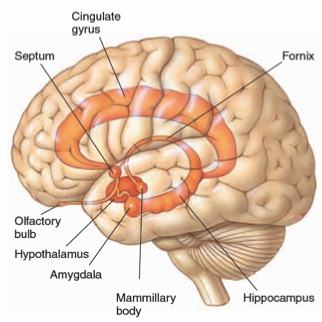
|
Limbic system - a collection of structures with a role in emotional behavior
Limbic system is ____________________ across mammals
Compared to lower mammals, primates have a smaller proportion dedicated to limbic because the frontal cortex expanded
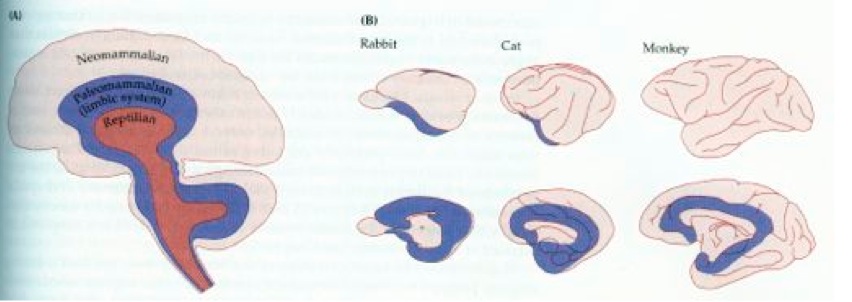
|
Amygdala
Revisited: Fear conditioning
Lesions to the amygdala ________________________ the freezing response
Amygdala sends output to areas responsible for the physical reactions (like hypothalamus)
Freezing, piloerection, cardiovascular response
Amygdala forms simple associations between stimuli and
positive/negative experience
________________________________
Review: What did the hippocampus do?
Theory: The hippocampus recognizes/remembers the context, the
amygdala binds the context to fear
Human: Amygdala & Fear
Task:
subjects observe different facial emotions during fMRI
Result:
amydala response is maximal for fearful faces
Theory:
Is amygdala needed for experiencing or understanding emotions?
Understanding may require experiencing the emotion for oneself
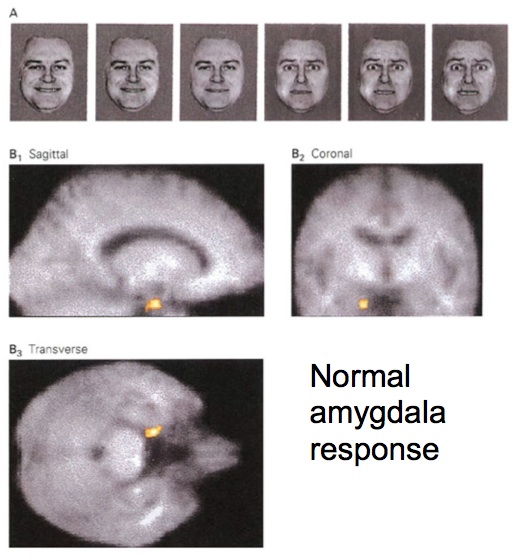
Source: Morris et al, Nature 1996
|
Patients with Urbach-Wiethe disease (destroys the amygdala) are particularly deficient in describing/recognizing fear
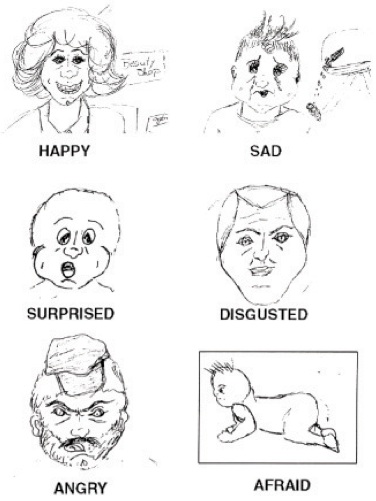
Source: Adolphs... & Damasio, Neuroscience 1995
|
Amygdala: Not only for fear
Patient DR had amygdala lesion (Scott et al, 1997)
Could recognize faces but not the emotion (especially not fear)
Also could not recognize emotional content of written or heard words
Hypothalamus
Diverse functions: controls or involved in: hormone release,
temperature regulation,food & water intake, sexual behavior, daily
cycles, emotional responses
Output to autonomic nervous system (ANS) to quickly control:
heart rate, digestion, respiration, salivation, perspiration, pupil dialation, sexual arousal
Output to endocrine system
____________________________________________________
____________________________
affects digestion, immune system, sexual arousal, energy levels, mood
related neurohormones: cortisol, epinephrine (adrenaline), norepinephrine
Role in emotion
serves as the interface between cognitive and ____________________________
Hippocampus
May not be directly involved in emotional associations,
but sometimes necessary for remembering stimuli that enter into emotional associations
(see "Revisted: Fear conditioning" above)
Prefrontal Cortex
Seat of executive functioning: impulse control, decision making, delayed gratification
The prefrontal cortex (hopefully) inhibits or tempers emotional reactions
Decorticate cat
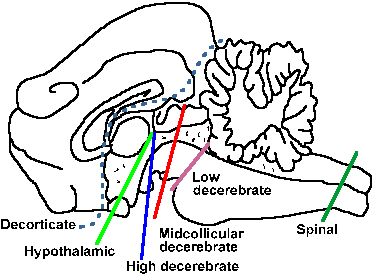
Source: michaeldmann.net/mann16.html
|
Cat had entire cortex removed
Left basal ganglia, limbic system, brain stem
Could do automatic behaviors like walking if placed on a treadmill
Cat was prone to ____________________
Aggressive / violent behavior with little or no provocation
Must have hypothalamus intact
Lack of cortex to inhibit inappropriate emotional reactions
|
Stress
stress - direct threats, perceived threats, feelings of strain
Pathways
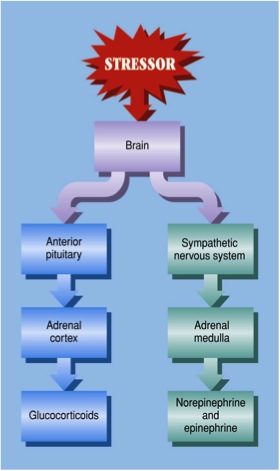
|
Brain
Limbic system - perceive directly stressful stimuli (fear conditioning)
Cortex - interpret complex situations as stressful (is my boss mad?)
Hypothalamus - interface with pituitary gland & endocrine system
Anterior pituitary system
Release ____________________________ from adrenal cortex
mobilize energy, combat inflammation, assist in healing
release ____________________ - natural pain killers
Sympathetic nervous system
Release ____________ and ____________ (EPI = adrenaline)
Norepinephrine & epinephrine physically mobilize the body,
but circulating NOR/EPI also improve encoding of memories
Help "lock in" important stimuli
(remember the threat/experience)
|
Stress as Adaptive
In life threatening situations
Mobilizes the body, reduces perception of pain
In critical learning situations
EPI/NOR improve sensation & memory
In brief, manageable situations - ____________ stress
Boast the immune response
Stress as Maladaptive
In ongoing, unmanageable situations - ____________ stress
Prevents the body from returning to homeostasis
Weakens the immune system, poor tissue growth, energy mismanagement, depression
Serotonin

Source: en.wikipedia.org/wiki/Serotonin
|
Review:
A monoamine neurotransmitter (same family as dopamine, epinephrine, norephinephrine)
Released from neurons with cell bodies in brain stem and distributed to a diverse brain areas
Released from raphe nuclei in brain stem
|
in simpler organisms, including ____________________ serotonin is primarily involved with ____________ behavior
roughly 80-90% of the human body's serotonin is in the gut, 10% in the CNS
Can produce feelings of satiety (having enough food)
With sufficient serotonin, rats consume less food and shift away from fatty foods (Clifton, 2000)
Low serotonin is associated with agitation & sluggishness
Depression - helped by increased serotonin in synapses
Selective serotonin reuptake inhibits (SSRI) - fluoxetine (____________) was first SSRI to be approved
regulates ______________________________________
Drugs that act on serotonin:
psilocybin (shrooms), mescaline, LSD, MDMA are agonists of the serotonin receptors
Summary:
a sense of satiety/well-being is associated with proper serotonin functioning
Summary
- Dopamine is critically involved in pleasure, reward and the motivation to learn
- Amygala is the site of simple emotional memories - notably but not only fear
- Hypothalamus is the gateway to physiological responses, which are fundamental to emotion reactions
- Prefrontal cortex is involved in overriding or reconsidering our emotional reactions
- Proper serotonin functioning is associated with a sense of satiety and well-being
Copyright 2012 - Michael Claffey






